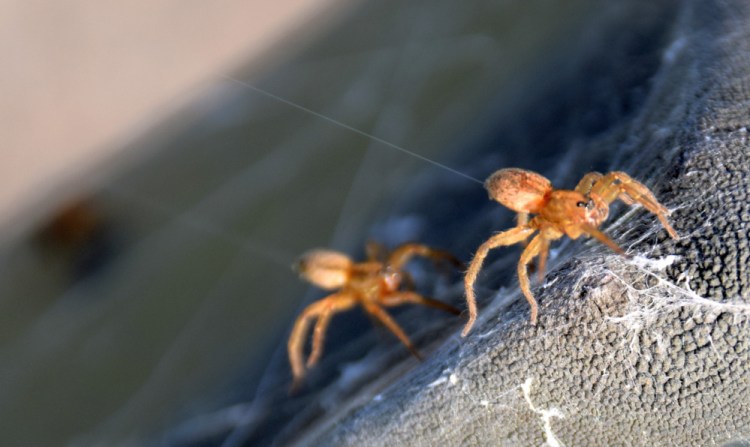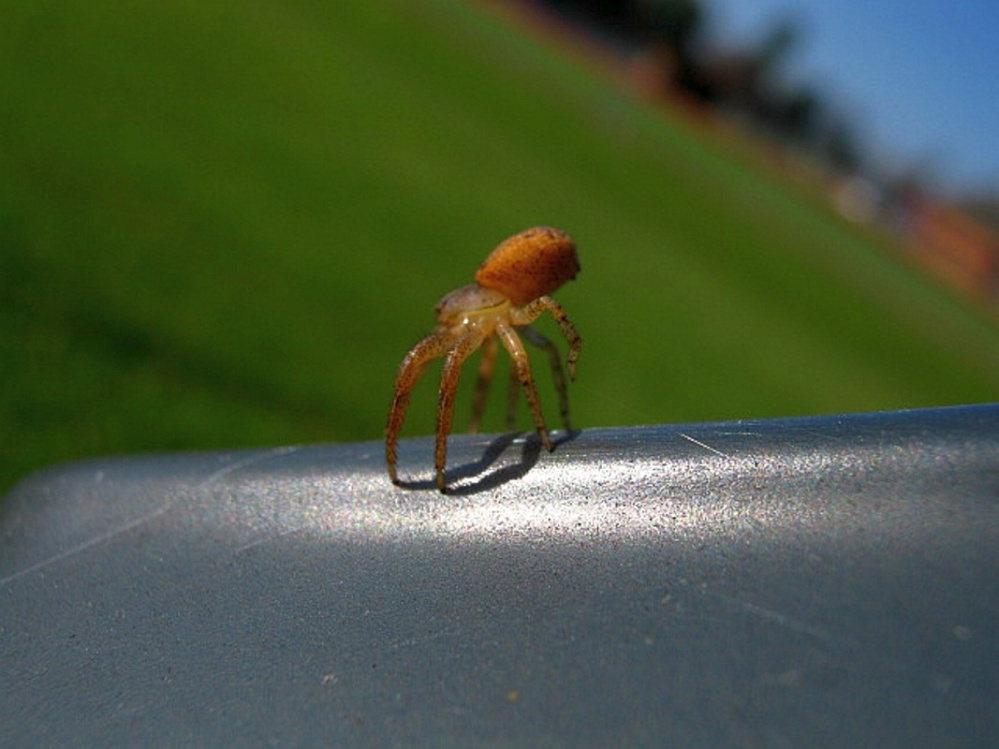On a breezy, sunny afternoon last month in the Unity park, two women were peering at the back of a bench near the road, which I thought was kind of weird because usually I’m the one exhibiting the odd behavior. Looking for spiders, I mean, usually furrow spiders who seem to find that bench a perfect place for their orb webs.
When I got to them, it turned out the two women had come upon a big crowd of young wolf spiders running back and forth along the bench. “We’re covered in cobwebs!” one of the women said. And sure enough, you could see glints of silk flapping in the breeze and strands lying on the bench, on the new grass and the walking track, and dangling off the women’s clothes.
What was happening, I shortly realized (never having seen this as a group activity before), was the spiderlings were ballooning — setting off to seek their fortunes by throwing silk onto the wind and using it like a kite to fly off to points unknown.
It’s true — many spiders fly, even though they don’t have wings. To get airborne, different species arrange the silk in different ways. They find an open perch like a tip of grass or a bench back on a breezy day, where some of them stand on tiptoe facing the wind, angle their backsides at 45 degrees and throw threads into the air that catch on the breeze. This is what the wolf spiderlings at the park appeared to be doing. Other species lay down a drag line of silk which they hold on to, and when a stiff enough breeze takes hold, the dragline breaks, a fray of silk from the spider balloons into the wind, and they fly away. Others loop threads of silk to make what amounts to a little kite, and when the breeze catches it, they take off.
Ballooning spiders fly as high as 200 feet, and aircraft crews have spotted squads of flying spiders as high as 14,000 feet. Darwin famously (among arachnophiles, anyway) wrote of his ship the Beagle encountering a huge crowd of ballooning spiders 60 miles out to sea, off South America. Because of their aeronautic adventuring, spiders are often the first sentient life to set up shop after natural disasters like fires, mudslides and floods.
Although they’re at the will of the wind, they can control their flight to some extent by changing body posture, slowing descent by splaying their legs and increasing speed by tucking the legs in. But as far as anyone knows, they have no control over where they end up. It’s thought that most don’t survive the voyage because they get eaten on the wing by birds such as swallows or swifts, or they land on water, where they drown or get snapped up by some other predator. When they land in an environment inhospitable to their species, they take off and try another flight.
The arachnologists indicate that ballooning takes place mostly in the late summer and fall, and the most active balloonists in our area are the sheetweb weavers, or members of the Linyphiidae family, notably the really tiny ones in a subfamily some arachnologists call the dwarf sheetweavers. But some orb weavers and hunters, including some crab spiders, jumping spiders and nursery web spiders, also go ballooning. These little wolf spiders, who are also hunters, had probably just recently hopped off their mothers’ backs after spending the first week or two of their lives riding around and being cared for. Now they were eagerly getting a head start on their summerlong lives.
Strands of silk were everywhere, floating off the bench in the wind and getting all over my clothes. I’ve never seen it happen, but when the group of balloonists is really large in a field, there’s so much silk that it collects together in sheets, and makes what we call gossamer — the material of the gown worn by Emily Dickinson’s character who is kindly given a ride by Death in his carriage.
Dana Wilde lives in Troy. You can contact him at naturalist1@dwildepress.net. His recent book is “Summer to Fall: Notes and Numina from the Maine Woods” available from North Country Press. Backyard Naturalist appears the second and fourth Thursdays each month.
Send questions/comments to the editors.






Comments are no longer available on this story